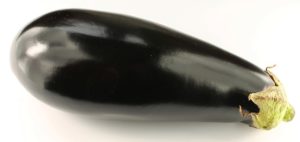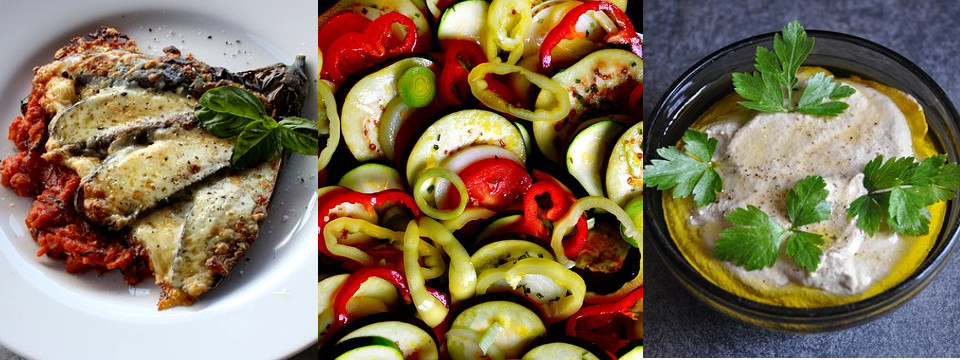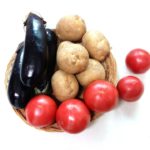
Nutrition experts agree that a key to healthy food choices includes many different brightly colored fruits and vegetables. Think about orange carrots, red peppers, green salad, red tomatoes, blue berries, and purple beets- all of these are great! But did your vision include the Blue-Black Eggplant?
Eggplants are actually FRUITS – not vegetables…. That is because, from a botanical perspective, the part of the plant that contains the seeds is the fruit- so that same concept refers to tomatoes and cucumbers – all fruits! Eggplant is called “aubergine” in England.
 The most popular form of eggplant in the US is the dark purple-blue-black larger heavy variety. This type of eggplant is actually native to Asia, although it is often considered an Italian food, used in classic Italian eggplant parmigiana or French Ratatouille, and also found in the popular Middle Eastern dish, baba ganoush.
The most popular form of eggplant in the US is the dark purple-blue-black larger heavy variety. This type of eggplant is actually native to Asia, although it is often considered an Italian food, used in classic Italian eggplant parmigiana or French Ratatouille, and also found in the popular Middle Eastern dish, baba ganoush.
 Each of the colors that brighten fruits and vegetables are actually associated with specific healthy naturally occurring compounds such as healthy phytochemicals known as anthocyanins. The deep blue-black color of eggplant is due to the presence of a high amount of anthocyanins. These natural components offers a high level of antioxidant benefits that protects cell surfaces against damage due to free radicals and toxins. Eggplant skin is rich in a particular anthocyanin, called nasunin, which has been shown to limit angiogenesis- the growth of new blood vessels which feed tumors. Please note that the most nutritious part of the eggplant is actually the PEEL! Consider leaving some of the peel on when preparing eggplant dishes. The peel will soften and cook right into the food preparation. It MAY have a slight bitter aftertaste, which is actually more interesting and aids digestion.
Each of the colors that brighten fruits and vegetables are actually associated with specific healthy naturally occurring compounds such as healthy phytochemicals known as anthocyanins. The deep blue-black color of eggplant is due to the presence of a high amount of anthocyanins. These natural components offers a high level of antioxidant benefits that protects cell surfaces against damage due to free radicals and toxins. Eggplant skin is rich in a particular anthocyanin, called nasunin, which has been shown to limit angiogenesis- the growth of new blood vessels which feed tumors. Please note that the most nutritious part of the eggplant is actually the PEEL! Consider leaving some of the peel on when preparing eggplant dishes. The peel will soften and cook right into the food preparation. It MAY have a slight bitter aftertaste, which is actually more interesting and aids digestion.
The inner part of the eggplant is not particularly rich in vitamins and minerals, with the exception of the mineral manganese. Manganese is needed by the body to act as a part of important enzymes that break down and process cholesterol, amino acids and carbohydrates. However eggplant offers other nutritional benefits. It is very low in calories and carbohydrates and high in fiber– two big plus factors! A full pound of eggplant only has 100 calories, so eating a large portion can lead to feeling satisfied without putting on the pounds. That is because eggplant contains a lot of water. Eggplant is also very low on the glycemic index. The glycemic index indicates the effect of a particular food on blood glucose level. Low glycemic foods help with blood sugar maintenance and weight control. Eggplant rates a very low glycemic index of “1”.
Eggplant is a perfect choice in a wide variety of dietary styles, such as Mediterranean, Paleo, Low Carb, Vegan,Vegetarian , and even the eclectic FODMAP diet! FODMAP stands for “Fermentable Oligo-, Di-, Mono-saccharides And Polyols”. Some people find that when they eat Low FODMAP foods they feel a lot better!
 One caveat is that Eggplant is part of the Nightshade family, along with potatoes, tomatoes and peppers. About 30% of people who suffer from arthritis and joint pain have nightshade sensitivities. I always tell clients who have these issues to totally give up nightshades for 30 days – this includes tomato sauces and ketchup! If the person IS nightshade sensitive, they will notice a marked improvement, and there is absolutely NO ADVERSE EFFECT to giving it a try, unlike the possible devastating effects of some pain reducing pharmaceutical drugs.
One caveat is that Eggplant is part of the Nightshade family, along with potatoes, tomatoes and peppers. About 30% of people who suffer from arthritis and joint pain have nightshade sensitivities. I always tell clients who have these issues to totally give up nightshades for 30 days – this includes tomato sauces and ketchup! If the person IS nightshade sensitive, they will notice a marked improvement, and there is absolutely NO ADVERSE EFFECT to giving it a try, unlike the possible devastating effects of some pain reducing pharmaceutical drugs.
So experiment with the versatile, low calorie filler upper- EGGPLANT, as you plan your healthy eating regimen for the New Year!
